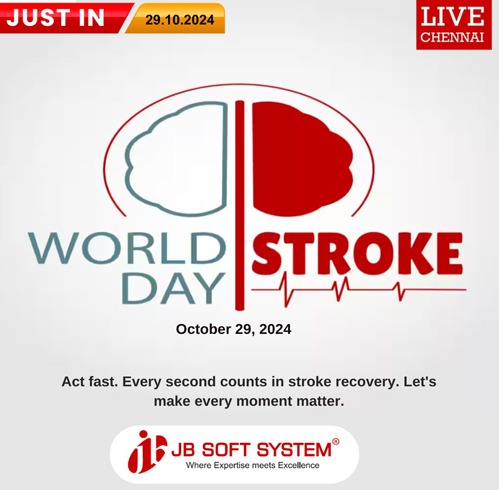Stroke remains one of the world’s leading causes of death and disability. This World Stroke Day, we’re bringing attention to a critical yet often overlooked risk factor: high blood pressure, also known as hypertension. Nearly half of all adults around the globe are affected by high blood pressure, and more than half of all strokes are associated with this silent but deadly condition. Regular blood pressure monitoring, healthy lifestyle choices, and proper medical guidance are key in the fight against stroke.
What is a Stroke?
A stroke occurs when the brain`s blood supply is suddenly disrupted, either by a blood clot blocking an artery or when a blood vessel in the brain bursts, leading to a hemorrhagic stroke. When this happens, brain cells begin to die within minutes, leading to permanent brain damage or even death if not treated immediately. Rapid action is critical to minimize damage, and awareness about stroke symptoms and prevention can save lives.
Understanding High Blood Pressure and Its Role in Stroke
High blood pressure, which often has no noticeable symptoms, silently damages the blood vessels over time, leading to complications like heart disease, kidney damage, and stroke. When left unmanaged, hypertension causes wear and tear on the heart, arteries, and blood vessels, increasing the risk of blockages and bleeding in the brain.
According to health experts, the only way to confirm high blood pressure is through regular checkups. Blood pressure readings have two values: the systolic (upper number) and diastolic (lower number).
Here’s a quick breakdown:
– Normal: Less than 120/80 mm Hg
– Elevated: Systolic 120-129 and diastolic less than 80 mm Hg
– High Blood Pressure (Stage 1): Systolic 130-139 or diastolic 80-89 mm Hg
– High Blood Pressure (Stage 2): Systolic 140 or above, or diastolic 90 or higher
– Hypertensive Crisis: Higher than 180/120 mm Hg (urgent medical attention needed)
Causes of High Blood Pressure
Several factors contribute to elevated blood pressure, with some risk factors being beyond an individual`s control:
– Age: Risk increases with age, particularly over 65.
– Genetics and Ethnicity: Family history and certain ethnic backgrounds, such as Polynesian, Afro-Caribbean, or South Asian, increase risk.
– Pregnancy and Pre-existing Health Conditions: Pregnancy and conditions like diabetes and kidney disease contribute to higher risks.
Lifestyle Choices to Manage and Prevent High Blood Pressure
While genetics and age play a role, adopting healthy habits is crucial in managing blood pressure and reducing stroke risk. Here are some evidence-based strategies for stroke prevention:
1. Regular Exercise: Thirty minutes of brisk activity five days a week can lower blood pressure and stroke risk.2. Healthy Diet: Reduce processed foods, which are high in salt, sugar, and unhealthy fats. Prioritize fruits, vegetables, whole grains, and lean proteins.
3. Weight Management: Being overweight, especially around the abdomen, puts extra strain on the heart.
4. Cholesterol Control: Elevated cholesterol can worsen high blood pressure. A diet low in saturated fats and regular exercise can help maintain healthy cholesterol levels.
5. Limit Alcohol and Avoid Tobacco: Moderate alcohol intake (no more than 2 units per day) and quitting smoking can lower blood pressure significantly.
6. Stress Management: Chronic stress and poor coping mechanisms can contribute to high blood pressure. Mindfulness and regular physical activity are effective stress relievers.
The Importance of Early Detection and Treatment
World Stroke Day is a reminder to prioritize health checks and encourage lifestyle changes that can prevent strokes. If diagnosed with high blood pressure, consult healthcare professionals for personalized management plans. In some cases, medication may be necessary, and adherence to medical advice is crucial for lowering stroke risks.
Act Now, Live Better
Taking proactive steps to check blood pressure, adopt a healthier lifestyle, and support loved ones in doing the same can create a powerful impact in the battle against stroke. Remember, early intervention saves lives—let`s make every moment count. This World Stroke Day, let’s all commit to raising awareness and taking action to protect ourselves and our communities from stroke.
Stay informed, act fast, and make your health a priority. Together, we can make a difference.


